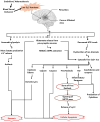Ischemic Stroke: Pathophysiology and Evolving Treatment Approaches
- PMID: 39444789
- PMCID: PMC11497522
- DOI: 10.1177/26331055241292600
Ischemic Stroke: Pathophysiology and Evolving Treatment Approaches
Abstract
Stroke remains a leading cause of mortality and disability, with ischemic stroke being the most common type. It occurs due to reduced cerebral blood flow, leading to a cascade of events initiated by oxygen and nutrient deprivation, triggering excitotoxicity, oxidative stress, and inflammation and finally culminating in neuronal injury and death. Key molecular players in ischemic stroke include glutamate receptors, acid-sensing ion channels, and purinergic receptors, exacerbating cellular damage through calcium influx, oxidative stress, and mitochondrial dysfunction. Understanding these mechanisms has shaped therapeutic strategies, such as neuroprotective agents and stem cell therapies. Current treatments such as tissue plasminogen activator (tPA) emphasize timely intervention, yet challenges persist in patient-specific variability and accessibility. This review provides an overview of ischemic stroke pathophysiology, emphasizing cellular responses to ischemia and current and future therapeutic approaches including stem cell therapies aimed at mitigating stroke-induced disabilities and improving long-term outcomes.
Keywords: ASIC; Ischemic stroke; NMDA; ion channels; stroke therapy.
© The Author(s) 2024.
Conflict of interest statement
The author(s) declared no potential conflicts of interest with respect to the research, authorship, and/or publication of this article.
Figures




Similar articles
-
Proton-sensitive cation channels and ion exchangers in ischemic brain injury: new therapeutic targets for stroke?Prog Neurobiol. 2014 Apr;115:189-209. doi: 10.1016/j.pneurobio.2013.12.008. Epub 2014 Jan 24. Prog Neurobiol. 2014. PMID: 24467911 Free PMC article. Review.
-
Pathophysiologic mechanisms of acute ischemic stroke: An overview with emphasis on therapeutic significance beyond thrombolysis.Pathophysiology. 2010 Jun;17(3):197-218. doi: 10.1016/j.pathophys.2009.12.001. Epub 2010 Jan 13. Pathophysiology. 2010. PMID: 20074922
-
Disrupted Ionic Homeostasis in Ischemic Stroke and New Therapeutic Targets.J Stroke Cerebrovasc Dis. 2017 Dec;26(12):2706-2719. doi: 10.1016/j.jstrokecerebrovasdis.2017.09.011. Epub 2017 Oct 18. J Stroke Cerebrovasc Dis. 2017. PMID: 29054733 Review.
-
Salidroside derivative SHPL-49 attenuates glutamate excitotoxicity in acute ischemic stroke via promoting NR2A-CAMKⅡα-Akt /CREB pathway.Phytomedicine. 2024 Nov;134:155583. doi: 10.1016/j.phymed.2024.155583. Epub 2024 Apr 2. Phytomedicine. 2024. PMID: 39173548
-
Potential Neuroprotective Treatment of Stroke: Targeting Excitotoxicity, Oxidative Stress, and Inflammation.Front Neurosci. 2019 Sep 27;13:1036. doi: 10.3389/fnins.2019.01036. eCollection 2019. Front Neurosci. 2019. PMID: 31611768 Free PMC article. Review.
Cited by
-
Advancing neuroimaging: novel manganese- and iron-based MRI contrast agents for cerebral ischemic diseases.Discov Nano. 2025 Aug 18;20(1):142. doi: 10.1186/s11671-025-04325-4. Discov Nano. 2025. PMID: 40824432 Free PMC article. Review.
-
Future Perspectives of NMDAR in CNS Disorders.Molecules. 2025 Feb 14;30(4):877. doi: 10.3390/molecules30040877. Molecules. 2025. PMID: 40005187 Free PMC article. Review.
-
Targeting CX3CR1 Signaling Dynamics: A Critical Determinant in the Temporal Regulation of Post-Stroke Neurorepair.Brain Sci. 2025 Jul 17;15(7):759. doi: 10.3390/brainsci15070759. Brain Sci. 2025. PMID: 40722349 Free PMC article. Review.
-
Prevalence of Stroke in Spain and Its Impact on Quality of Life: Socioeconomic Inequalities and Access to Rehabilitation.Healthcare (Basel). 2025 May 6;13(9):1075. doi: 10.3390/healthcare13091075. Healthcare (Basel). 2025. PMID: 40361854 Free PMC article.
-
The effectiveness of theta burst stimulation for motor recovery after stroke: a systematic review.Eur J Med Res. 2024 Nov 29;29(1):568. doi: 10.1186/s40001-024-02170-2. Eur J Med Res. 2024. PMID: 39609900 Free PMC article.
References
-
- Hisham NF, Bayraktutan U. Epidemiology, pathophysiology, and treatment of hypertension in ischaemic stroke patients. J Stroke Cerebrovasc Dis. 2013;22:e4-14. - PubMed
-
- Jain M, Gupta S, Rijhwani P, et al. Prevalence of hemorrhagic stroke subtypes, etiological causes and its association with various stroke related risk factors: an observational study. J Mahatma J Univ Med Sci Technol. 2023;7:78-83.
-
- Unnithan A, Das J, Mehta P. Hemorrhagic Stroke. 2023. - PubMed
Publication types
LinkOut - more resources
Full Text Sources

